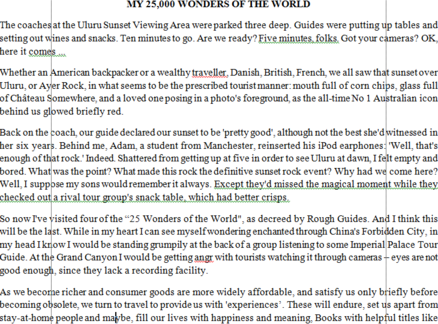Read the following passage and mark the letter A, B, C, or D to indicate the correct answer to each of the question.
If you go back far enough, everything lived in the sea. At various points in evolutionary history, enterprising individuals within many different animal groups moved out onto the land, sometimes even to the most parched deserts, taking their own private seawater with them in blood and cellular fluids. In addition to the reptiles, birds, mammals and insects which we see all around us, other groups that have succeeded out of water include scorpions, snails, crustaceans such as woodlice and land crabs, millipedes and centipedes, spiders and various worms. And we mustn't forget the plants, without whose prior invasion of the land, none of the other migrations could have happened.
Moving from water to land involved a major redesign of every aspect of life, including breathing and reproduction. Nevertheless, a good number of thoroughgoing land animals later turned around, abandoned their hard-earned terrestrial re-tooling, and returned to the water again. Seals have only gone part way back. They show us what the intermediates might have been like, on the way to extreme cases such as whales and dugongs. Whales [including the small whales we call dolphins] and dugongs, with their close cousins, the manatees, ceased to be land creatures altogether and reverted to the full marine habits of their remote ancestors. They don't even come ashore to breed. They do, however, still breathe air, having never developed anything equivalent to the gills of their earlier marine incarnation. Turtles went back to the sea a very long time ago and, like all vertebrate returnees to the water, they breathe air. However, they are, in one respect, less fully given back to the water than whales or dugongs, for turtles still lay their eggs on beaches.
There is evidence that all modern turtles are descended from a terrestrial ancestor which lived before most of the dinosaurs. There are two key fossils called Proganochelys quenstedti and Palaeochersis talampayensis dating from early dinosaur times, which appear to be close to the ancestry of all modern turtles and tortoise. You might wonder how we can tell whether fossil animals lived in land or in water, especially if only fragments are found. Sometimes it's obvious. lchthyosaurs were reptilian contemporaries of the dinosaurs, with fins and streamlined bodies. The fossils look like dolphins and they surely lived like dolphins, in the water. With turtles it is a little less obvious. One way to tell is by
measuring the bones of their forelimbs.
The word “ceased" in paragraph 2 mostly means__________
A. stopped happening or existing
B. got familiar
C. began to happen or exist
D. decided to become




Đáp án A
Từ "ceased” trong đoạn 2 có nghĩa là______
A. dừng xảy ra hay tồn tại B. quen với
C. bắt đầu diễn ra hay tồn tại D. quyết định trở thành
Từ đồng nghĩa: ceased [chấm dứt) = stopped happening or existing
“Whales (including the small whales we call dolphins) and dugongs, with their Close cousins the manatees, ceased to be land creatures altogether and reverted to the full marine habits of their remote ancestors.” (Cá voi (bao gồm có những con cá voi nhỏ mà chúng ta gọi là cá heo) và cá nược, với những người anh em họ thân thiết của chúng - lợn biển, đã hoàn toàn không còn là sinh vật trên cạn và trở lại tốt có thói quen ở biển của tổ tiên xa xôi).